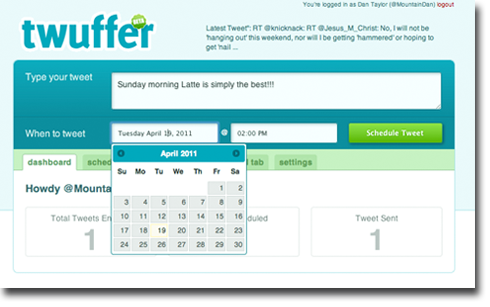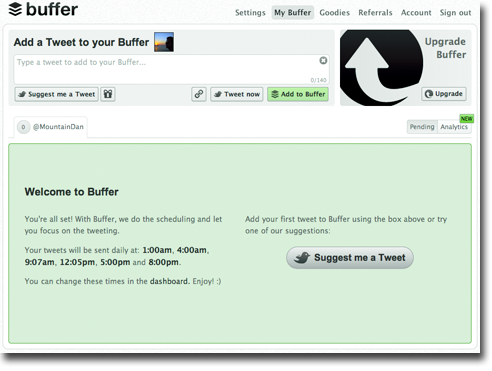
By definition, social media is meant to be just that, social. The argument to automate your Twitter feed or not can be hashed and rehashed over and over, but some facts remain the same; there are people behind the mechanisms. And as human beings, whether we like it or not, we’re not meant to work 24/7, and occasionally need to sleep.
In today’s Twitterverse, there are a number of tools such as HootSuite, CoTweet, and TweetDeck that can offer users an almost overwhelming array of options. But what if you want to provide valuee to your followers throughout the entire 24- hour day, and don’t need all the bells and whistles of a full-blown social media package?
Let’s take a look at 4 minimal Twitter automation tools that can help you stay engaged, even while catching a few winks.
Free
Who doesn’t love free? These two tools are available free of charge, but also provide the bare minimum of features. If bare-bones is your style, these two are for you.
FutureTweets
![]() Admittedly, the UI is already starting to show signs of aging, but the service remains very well in tact. In fact, one of FutureTweet’s selling points is that it is so simple.
Admittedly, the UI is already starting to show signs of aging, but the service remains very well in tact. In fact, one of FutureTweet’s selling points is that it is so simple.
Sign in with your Twitter credentials, thereby authorizing the service. Likewise, the settings department is a one-click affair, a “Please set your time zone” option.
When it comes to scheduling, FutureTweets shines, as its minimalism makes it one of the easier tools in the bunch to use. Simply enter your tweet, select the publish time, date and schedule it. And even though FutureTweets runs lean and clean, there are a few niceties including a handy ASCII character, click to insert feature, as well as some text inverting Tom foolery, should you be so inclined. Likewise, FutureTweets also provides a rundown of your scheduled and published tweets, thus providing confirmation of publication for overly worried communications managers.

After speaking with FutureTweets developer Joost Ruyter, he made it clear that FutureTweets is receiving less of his attention these days, as he’s also developed LaterBro.com, a similar service, but with Facebook update functionality as well. It’s this service that’s been used by @FedExDelivers to keep the conversation flowing, even while representatives aren’t “on the clock”. He informs me that there’s also another project in the works, so stay tuned.
Twuffer
![]() Similar to FutureTweets, Twuffer offers up a simple, yet effective, set-it-and-forget-it tweet scheduler. Twuffer’s power lies in the fact the most of its features don’t clutter the interface until needed.
Similar to FutureTweets, Twuffer offers up a simple, yet effective, set-it-and-forget-it tweet scheduler. Twuffer’s power lies in the fact the most of its features don’t clutter the interface until needed.
Signup and login is a painless procedure, simply authorize the tool via your Twitter credentials, and you’re good to go. Twuffer’s settings take FutureTweet’s one step further and in addition to selecting your time zone; you’re also given the option to include your tweets in the Twuffer homepage stream, which really amounts to nothing more than an ongoing use case stream for Twuffer creator Grady Britton.
A clean and simple dashboard gives you a quick overview of number of tweets entered, scheduled, and sent. If you want to drill down further into the schedule, navigation tabs allow users to pinpoint scheduled tweets, sent tweets, and failed tweets.

One nicety about Twuffer is that the tweet input panel is readily available no matter which tab you’re viewing. And remember those not-there-until-needed options? When clicking in the text input area, a small indicator will popup giving you a character count. Likewise, when clicking the date and time input fields, a calendar and clock present users with handy options. Last by not least, Twuffer provides you with a handy reminder of your last tweet sent by posting it in the top right corner just above the new tweet text input field.
Freemium
While both of these services are available for free, they both offer reasonably affordable upgrade options that, when combined with proper analysis, can take your Twitter to a whole new level.
Timely
![]() Timely is brought to us by social marketing ROI experts Flowtown. As mentioned above, Timely operates on the freemium model, thus allowing users to get a taste of the functionality. From a minimalistic approach, the free version will suit users just fine, but it’s when you step up and upgrade to the Timely Pro version where a number of “Power User” features come to the forefront.
Timely is brought to us by social marketing ROI experts Flowtown. As mentioned above, Timely operates on the freemium model, thus allowing users to get a taste of the functionality. From a minimalistic approach, the free version will suit users just fine, but it’s when you step up and upgrade to the Timely Pro version where a number of “Power User” features come to the forefront.
Timely is unique in the fact that users are not allowed to schedule the time of release of their scheduled tweets. Rather, the tool analyzes you last 199 tweets, and automagically determines the optimal release time. Feeding back into itself, Timely regularly gathers data and adjusts its timings based on additional tweets. Flowtown CEO and Co-Founder Ethan Bloch explains the mechanism at Quora:
- It pulls in your past 199 tweets and analyzes them for Retweets (native RTs only).
- It then plots 24 buckets, 1 for each hour in the day.
- It then assigns Tweets with RTs to it’s corresponding time bucket and ignores Tweets without RTs.
- It then applies the following calculation per time bucket: # of RTs in this bucket / # of RTs within the sample of 199 tweets.
- It then determines your optimal time buckets starting with best to worst performing and excludes.
Finally we perform some additional filters and qualifying to aid the user experience and expectations when using Timely, so it’s not just raw buckets.
On the options front, Timely keeps it simple, however offers a few that others don’t, including the option to toggle weekend tweeting on/off, as well as regulate the number of tweets per day. Timely also features a bit.ly option, which is certainly a nice tracking and analytics tool, as well as collaborative tweeting. The collaboration feature is particularly noteworthy, as here we have the first instance of a minimal Twitter tool offering powerful abilities for SMBs and corporations alike.

When it comes to the paid version, Timely offers two pricing options, $19.99/month, or $199 for the entire year. This paid service offers the option to export analytics (native and classic retweets, clicks, and reach). An unlimited number of RSS/Atom feeds can been set up within the paid version of Timely, and users can toggle the option to receive real-time notifications. Similar to LaterBro above, the paid Timely also offers options to schedule updates to Facebook.
Buffer
![]() Rounding out this toolset roundup, let’s have a look at Buffer. Originally highlighted by TNW writer Francis Tan in February, Buffer also operates under the freemium business model, and offers up a surprising number of features in its free version.
Rounding out this toolset roundup, let’s have a look at Buffer. Originally highlighted by TNW writer Francis Tan in February, Buffer also operates under the freemium business model, and offers up a surprising number of features in its free version.
Of all four tools profiled, Buffer was the only one that asked for an email address upon signup. It’s not quite clear what they’re doing with this information, as a sign up/login could be accomplished via an Oauth, but I’ve yet to receive any spam.
Buffer has one of the cleanest interfaces of all three profiled, and clearly team members Joel and Leo have experience in selling to consumers. All of Buffer’s Premium features are right out in the open, enticing users to dive right in. Once a field is entered in one of the premium features, a notice informs you that this is a Premium feature, and suggests you upgrade. Smart selling.

Of the features that are free, who would need more? A clean interface allows users to stack their preferred tweets in an easy to understand timeline, and will send you a one-time email reminder when your buffer is empty. Scheduled times are configurable under Settings, where you’ll also find the aforementioned upsell features which include bit.ly integration and collaborative, team tweeting.
When it comes to interactivity with the app, Buffer stands head and shoulders above the competition by offering a Chrome Extension, Safari Extension, and Universal Bookmarlet. Through these extensions, users can easily “fill the pipeline” with interesting articles or objects of interest without ever having to visit Buffer directly.
While not offered by Twuffer or FutureTweets, both Timely and Buffer offer a “suggested tweets” option. Timely’s is packed with only 5 canned quotes, while Buffer has recently sought to crowdsource suggested tweets moving forward. Likewise, they’ve addressed Francis’ note, and have added a tweet now button.
Of note: both Timely and Buffer offer analytics in their free packages. While Timely provides only basic information, retweets and reach (follower counts), Buffer offers an additional option, informing users of how many clicks the scheduled tweet received. This one feature can make all the difference when planning future Twitter campaigns, as well as a much better judge of not only who’s retweeting what you’re putting out, but also taking the critical step of actually clicking though to the link you’re likely to be sharing.
So whether you’re an SMB owner looking to engage your audience around the clock, or a multinational corporation looking for a minimal toolkit to keep readers from around the world informed, the 4 Twitter tools above can easily help you accomplish this goal. Sure there are a number of others out there that will also do the same, but again, they’re sometimes just a bit more than one needs.
Get the TNW newsletter
Get the most important tech news in your inbox each week.





